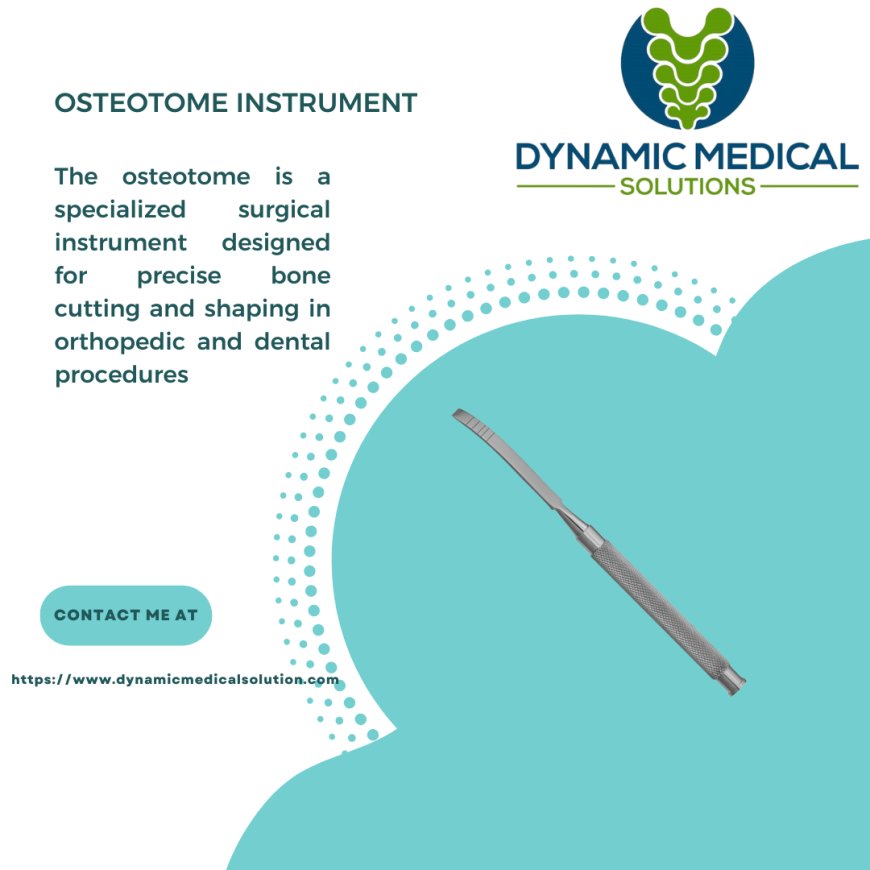Osteotome Instrument: A Precision Tool for Bone Surgery
The osteotome, a surgical instrument resembling a chisel, plays a crucial role in various surgical procedures

The osteotome, a surgical instrument resembling a chisel, plays a crucial role in various surgical procedures, particularly those involving bone. Osteotome Instrument Its primary function is to cut or shape bone, making it an indispensable tool in the hands of orthopedic, plastic, and dental surgeons. In this article, we delve into the intricacies of osteotome instruments, exploring their diverse applications, design variations, and the techniques employed in their use.
Understanding the Osteotome
An osteotome is typically crafted from high-quality stainless steel, ensuring durability and resistance to corrosion. The instrument features a sharp, beveled edge that is designed to penetrate and divide bone tissue. Osteotomes come in various shapes and sizes, each tailored to specific surgical needs. The most common types include:
-
Straight Osteotome: This type is characterized by a straight blade and is used for straightforward cutting tasks.
-
Curved Osteotome: With a curved blade, this osteotome is ideal for accessing and cutting bone in areas with limited visibility.
-
Chisel Osteotome: Resembling a traditional chisel, this tool is often used for heavy-duty bone cutting.
Applications of Osteotome Instruments
Osteotomes find application in a wide range of surgical procedures. Here are some of the key areas where these instruments are indispensable:
-
Orthopedic Surgery:
-
Joint Replacement Surgery: Osteotomes are used to prepare the bone surface for the implantation of artificial joints, such as hip and knee replacements.
-
Fracture Repair: In cases of complex fractures, osteotomes may be used to shape bone fragments for accurate alignment and fixation.
-
Bone Lengthening: Osteotomes are employed to cut bone segments, allowing for gradual lengthening procedures.
-
Plastic Surgery:
-
Facial Contouring: Osteotomes are used to reshape and contour facial bones, such as the chin and cheekbones.
-
Craniofacial Surgery: These instruments are essential for procedures involving the skull and facial bones, including corrective surgeries for birth defects or trauma.
-
Dental Surgery:
-
Dental Implant Placement: Osteotomes are used to create precise bone openings for the insertion of dental implants.
-
Wisdom Tooth Extraction: In some cases, osteotomes may be used to remove bone obstructing the removal of impacted wisdom teeth.
Techniques of Osteotome Use
The successful use of an osteotome requires a combination of skill and precision. Here are some key techniques employed by surgeons:
-
Direct Percussion: The surgeon directly strikes the osteotome with a mallet, generating the force needed to cut through bone.
-
Indirect Percussion: A mallet is used to strike a specialized instrument, such as a hammer handle or a chisel holder, which in turn transmits force to the osteotome.
-
Oscillating Saw Technique: In certain cases, an oscillating saw may be used to initiate a cut, followed by the precise shaping of the bone with an osteotome.
Safety Considerations
While osteotomes are invaluable surgical tools, it is essential to prioritize safety during their use. Here are some important safety considerations:
-
Sharp Edges: Osteotomes have sharp edges that can cause injury if not handled carefully. Surgeons must wear appropriate protective gloves and eyewear.
-
Bone Fragments: Bone fragments generated during osteotomy procedures can be hazardous. Proper suction and irrigation techniques are crucial to remove these fragments.
-
Infection Control: Strict adherence to aseptic techniques is essential to prevent infection. All instruments must be sterilized before and after use.
Conclusion
The osteotome, with its diverse applications and precise cutting capabilities, remains a fundamental tool in modern surgery. By understanding its various types, techniques of use, and safety considerations, surgeons can effectively harness the power of this instrument to achieve optimal surgical outcomes. As technology continues to advance, we can anticipate further refinements in osteotome design and surgical techniques, ensuring even greater precision and patient safety.
What's Your Reaction?


















